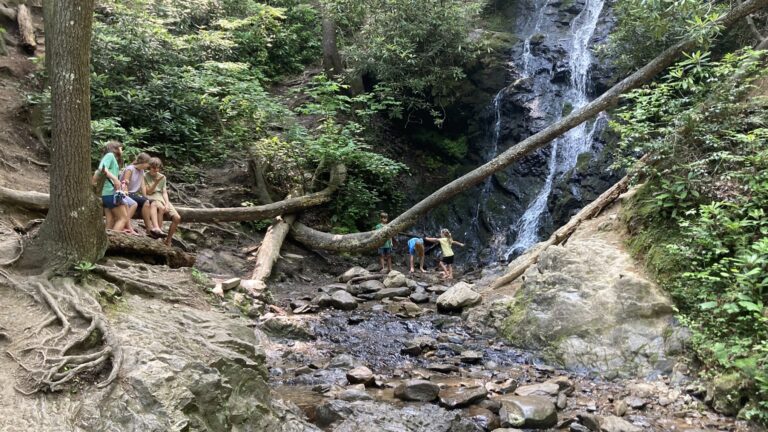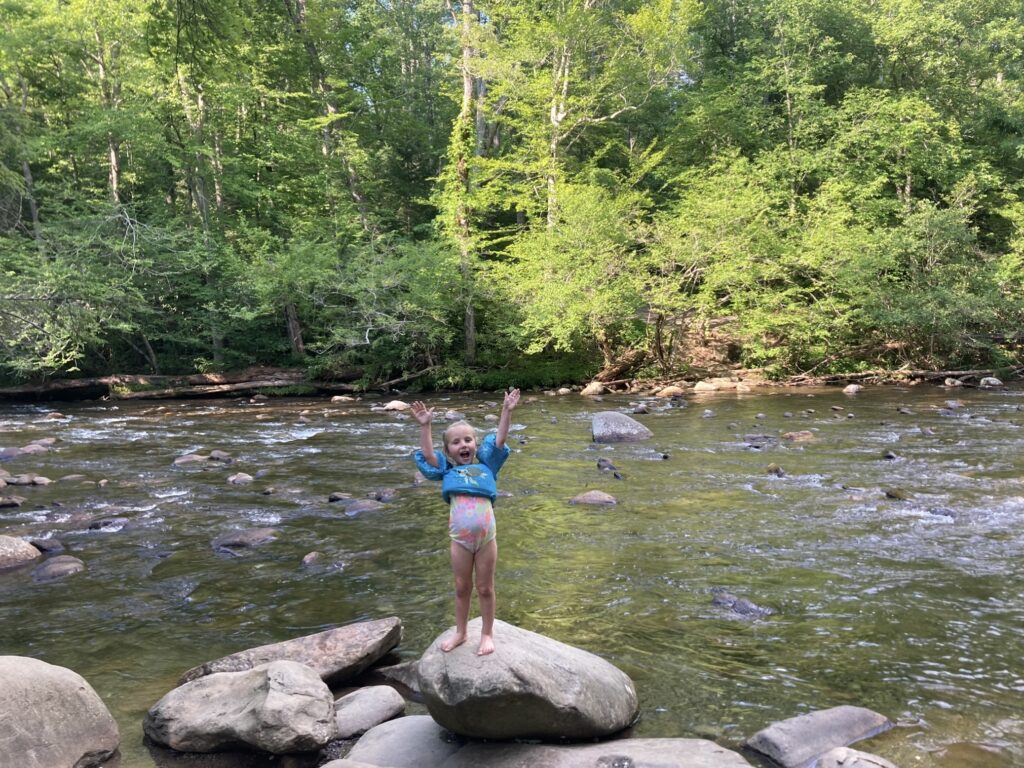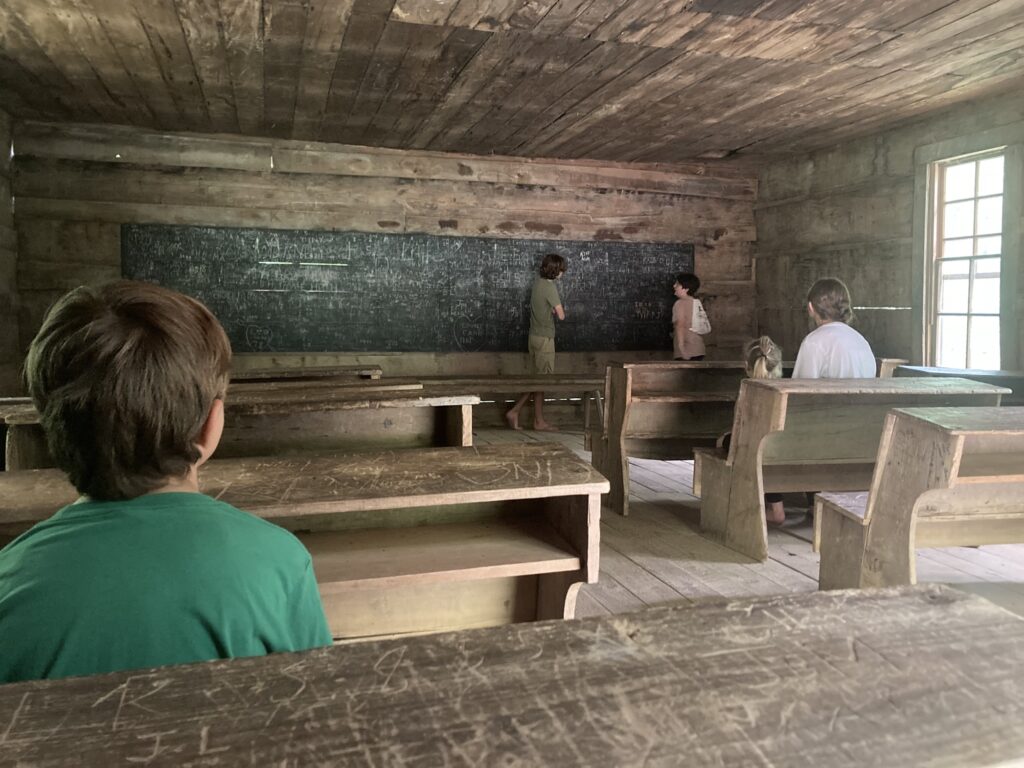
This summer, my traveling tribe had the pleasure of visiting Great Smoky Mountains National Park. This is the third time we’ve visited this particular park, and there’s a reason we keep returning: It’s fantastic!
Whether you prefer hiking, swimming, paddling, or scenic drives, there are plenty of things to do in Great Smoky Mountains National Park, and the surrounding area is full of beauty, fun, and welcoming people, making it an even more wonderful destination.
Planning to go RVing in Great Smoky Mountains National Park yourself? Here’s what I’ve learned during my visits.
Great Smoky Mountains National Park Hours and Fees
Before you go, you will want to make sure you know what to expect in terms of fees and parking. Here’s what we learned during our trip.
Park Hours
The park is open 24 hours a day. That said, certain things within the park do close. For instance, most visitor centers are open from 9:00am until 4:30pm or 5:00pm depending on the season. For this reason, it is a good idea to look at the hours for the specific location you wish to visit before you head out.
When to Visit
This is the most popular park in the NPS system. This means there can be some enormous crowds during certain times of year. We have only visited during May and June ourselves. While May was only moderately crowded, June was pretty darn busy.
My recommendation is to visit in May, August, or September in order to take advantage of lower crowd levels and nice weather. (Note: The one exception to this rule involves whether or not you want to see the amazing synchronous fireflies. In this case you will need to visit in June, but it is well worth it!)
You’ll also want to consider the time of day you visit. Most visitors arrive between 10:00am and 11:00am, meaning parking in the visitor center lots is very limited during these times. Consider arriving earlier or later for a better experience in terms of crowds. We experienced this firsthand one Sunday morning, and made sure to plan later visits for the rest of our trip.
Park Fees
Great Smoky Mountains National Park does not charge an entrance fee. That said, visitors are required to have parking tags in order to park anywhere in the park. These can be purchased at any of the visitor centers or at kiosks scattered throughout the park. It’s also possible to purchase parking tags online.
There are three types of parking tags:
- Daily — $5
- Weekly — $15
- Annual — $40
We chose to buy the weekly pass and definitely got our money’s worth. It’s important to note that unfortunately, interagency passes are not accepted. This was a major bummer for us.
Visitor Center Locations
Great Smoky Mountains National Park is home to four visitor centers:
- Sugarlands Visitor Center (near Gatlinburg, TN)
- Oconaluftee Visitor Center (near Cherokee, NC)
- Cades Cove Visitor Center (on the Cades Cove Loop)
- Clingmans Dome Visitor Contact Station
Our campground of choice has always been closest to the Sugarland Visitor Center, so we’ve been there several times and have enjoyed the exhibits about the local wildlife. We’ve also visited the Cades Cove Visitor Center in order to see the historic gristmill there.

Driving an RV in Great Smoky Mountains National Park
We chose not to drive our RV through the national park itself. That said, we could have driven our 32-foot travel trailer on the vast majority of the main roads throughout the park, and you can do the same as long as you’re comfortable driving an RV on mountain roads.
That said, there are a few secondary roads that could not handle an RV. In fact, RVs are prohibited from driving on these roads.
The roads that won’t work for RVs of any kind (except maybe a campervan) include:
- Balsam Mountain Road
- Greenbrier Road past the ranger station
- Heintooga Ridge Road
- Rich Mountain Road
- Roaring Fork Motor Nature Trail
- The road that exits the park at the Metcalf Bottoms Picnic Area
We drove that last road a couple times both ways, and it’s true, you absolutely would not want to drive an RV through there. (Honestly, even our car didn’t love it.)
Another thing to think about before driving an RV through the park? Parking. Unfortunately, many parking areas throughout the park cannot handle RVs—especially big ones, and especially when the park is crowded. For this reason, your best bet might be to park the RV at a visitor center and take a smaller car or a shuttle to go exploring.
Great Smoky Mountains National Park RV Camping
Wondering where to stay while visiting the Smokies? Fortunately, there are tons of options. From offsite campgrounds to campgrounds within the national park, you’re sure to find something that works for you.
Where We Stayed: Douglas Dam Campgrounds
Every time we have visited this part of the country, we have stayed in one of the two Douglas Dam campgrounds. These campgrounds are owned and operated by the Tennessee Valley Authority.
There is one campground set on one side of the dam, and a second set on the other end. Aptly named Douglas Headwater Campground and Douglas Tailwater Campground, they are equally nice and the cost to camp is very affordable at both. In fact, these are the least expensive RV campgrounds we could find in the area.
Every RV site in these campgrounds is equipped with potable water and a 30-amp electric hookup. Bathhouses are available and are clean enough, if a bit basic. There is also an onsite dump station and playgrounds are available for the littles.
The only major downside is that getting to the national park does require a bit of a drive. As an example, it took us the better part of an hour to reach Sugarlands Visitor Center. Still, I do recommend the Douglas Dam campgrounds for those on a budget, and will likely continue staying there when we visit the area.
Other Offsite Campground Options
Smoky Bear Campground and RV Park
Smoky Bear Campground and RV Park is located in Gatlinburg, Tennessee, so you’ll have a front-row seat for all the goings-on both inside and outside of the park proper. Amenities include full-hookup sites as well as a heated pool, bathhouse, and laundry facilities. You can also cook a stellar meal in the fully functional, well-stocked clubhouse kitchen.
Smoky Mountain Premier RV Resort
Smoky Mountain Premier RV Resort is a great place for Great Smoky Mountains National Park camping. It caters specifically to large rigs, so if you’re traveling in a 45-foot diesel pusher, be sure to check them out. Recently acquired by KOA, this campground is in the Pigeon Forge area and offers playgrounds, cornhole, horseshoes, laundry facilities, and a fitness room on top of its generous, full-hookup campsites.
Jellystone Park Pigeon Forge
Jellystone Park Pigeon Forge keeps the whole family busy and smiling from the start of your vacation to its very end—even if, for some reason, you never have a chance to get into the national park itself. With tons of fun and family-friendly activities (not to mention the wider range of things to do in the town of Pigeon Forge), there’s no end of mountain shenanigans to get into when you stay at Jellystone.
Yogi in the Smokies
Yogi in the Smokies is tucked just about in the middle of the park from north to south, in the North Carolina gateway town of Cherokee. It has many of the amazing activities and amenities you expect every time you stay at a Jellystone family resort, all coupled with the relaxing atmosphere of a town that’s not quite as hustlin’ and bustlin’ as Gatlinburg and Pigeon Forge. And, you’re still just moments away from the park gates, including many of the most popular in-park attractions like Clingmans Dome and the Continental Divide.
On-Site Campgrounds
Great Smoky Mountains National Park RV camping is also possible at the plethora of on-site campgrounds. Nine of its NPS-managed locations are developed, and of these, eight are at least somewhat RV-friendly. It is important to note however that size restrictions vary, and none of them offer full hookups.
In all cases, advanced reservations are highly recommended if you plan to stay at an onsite campground. These reservations can be made either online or by phone call.
Here are the on-site campgrounds in Great Smoky Mountains National Park that allow travel trailers and motorhomes:
- Abrams Creek Campground has 16 available sites, which are open between May and October. The maximum RV length is 12 feet.
- Balsam Mountain Campground offers 43 sites for RVs up to 30 feet in length, and is also open seasonally.
- Cades Cove Campground is a great place to create a home base while you explore the park, and welcomes RVs up to 35 feet in length.
- Cataloochee Campground is open to RVs up to 31 feet in length, but is accessed by a long and winding gravel road that may prove difficult for certain rigs. Advanced reservations are not just recommended but required throughout the entire season.
- Cosby Campground accommodates RVs up to 25 feet in length between May and October, and boasts 157 sites.
- Deep Creek Campground, despite its name, sits at 1800 feet of elevation, and RVs up to 26 feet long are welcome.
- Elkmont Campground is, as discussed above, RV-friendly, accommodating travel trailers of up to 32 feet and motorhomes of up to 35 feet in length. It also features nearby dump station access.
- Smokemont Campground has the most generous size restrictions, allowing trailers of up to 35 feet and motorhomes up to 40 feet. Its 142 sites are available for camping all year round.

Top Things to Do in Great Smoky Mountains National Park
Now that you know when to visit, how much to budget, and where to stay, let’s talk about things to do in the Smoky Mountains. We’ve enjoyed numerous activities in these parks, and below are our top picks.
Hike Away
We absolutely love hiking in the Smokies. One of our favorite trails is actually a really simple nature hike behind the Sugarlands Visitor Center called the Fighting Creek Nature Trail to Cataract Falls. The trail winds its way through the woods, crossing a stream, passing an old cabin, and eventually leading you to a lovely little waterfall.
Other hikes we have enjoyed with our kids include:
- Little Brier Gap Trail (to the old schoolhouse)
- Trillium Gap Trail to Grotto Falls (amazing waterfall)
- Cucumber Gap and Little River Loop Trail (swimming spots, fireflies, and bears, oh my!)
Step Back in Time
The imaginative kids in our group absolutely loved visiting all of the historic buildings and pretending they lived in the “old days.” As mentioned above, we hiked to the old schoolhouse and the kids played school for quite some time. We also spent time in the cabin on Fighting Creek Nature Trail and made sure to stop at the cabins along Cades Cove Loop.
Go for a Swim
Swimming was my kids’ favorite part of our most recent trip to Great Smoky Mountains National Park. We chose to swim in the river at Metcalf Bottoms Picnic area and appreciated that there was a small shallow area for our preschooler, as well as plenty of slightly deeper spots for the big kids. We saw a lot of people floating around in tubes, as well as some people fishing.
Not sure Metcalf Bottoms is the perfect swimming spot for your crew? There are plenty of others. These include:
- The Townsend Wye
- The Sinks
- Midnight Hole
- Greenbrier Cove
Go on a Driving Tour
During our most recent trip, we finally made it to the Cades Cove Loop. This is an 11-mile one-way road that circles Cades Cove and offers plenty of stopping points for hiking, picnicking, sightseeing, etc. We stopped at a few old houses and saw quite a few animals, including turkeys and a few bears.
We also made a stop at the visitor center, which is halfway around the loop. This is a good place to use the restroom, refill water bottles, and check out the old grist mill.
See the Fireflies
Seeing the synchronous fireflies of the Great Smoky Mountains was easily one of the most amazing experiences I’ve had in our years of full time travel. The fireflies light up in unison, creating a natural light show in the middle of the woods.
In addition to the synchronous fireflies, the park also features a huge number of regular fireflies. These come out every night at dusk and fill the air with a special kind of magic.
To see all of these fireflies, you do have to visit during the right time of year. Typically, the synchronous fireflies are at their peak in late May or early-to-mid June, and the other fireflies are out during this time as well. That said, in order to view the fireflies during peak week, you must enter and win a lottery, so be sure to do that before you go.
If you do not win a lottery ticket, don’t worry! It is still possible to see the synchronous fireflies before or after peak. We went a couple of days after peak week and still saw an amazing spectacle. Just make sure you arrive at the Little River Trail Head well before sunset to secure a parking spot, as the lot does fill up and rangers will turn extra vehicles away.
Watch for Wildlife
We mentioned the bears and turkeys we saw on Cades Cove Loop, as well as the incredible number of fireflies spotted throughout the park. This is not at all uncommon. In fact, you will likely see a huge number of animals while hanging out in the park.
As it happens, the Smokies is the salamander capital of the world, and spotting the water-loving critters is easy when playing in the river or creek. Otters are known to play in the river, and bears are abundant throughout the park.
Keep an eye out and see what amazing creatures you might see! Just be sure not to feed or approach any wild animals under any circumstances.
Clearly, there are tons of amazing things to do in the Smoky Mountains, making it an ideal RV destination. Ready to go see it for yourself? My family and I highly recommend it! Rent an RV and book your campground today so you can head out sooner rather than later.






